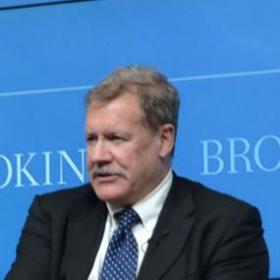
Exporting Security: NATO Teams Up with Russia
“An attack on Russia would be regarded as an attack on NATO!” In November 2013, ten months after being sworn in as President of the United States for a second term, this is President Obama’s declaration to the NATO summit.
The United States and NATO had provided a similar security guarantee to Japan for decades, which in the 1980s was often called the “sixteenth member” of NATO. In 1969, the United States gave a similar private assurance to the Soviet Union when Moscow was considering nuclear retaliation against an increasingly belligerent China in the grip of the Cultural Revolution.
In 2009, under a new wave of military reforms instituted by President Medvedev, and backed by Prime Minister Putin, Russia began dismantling what was left of its capability for protracted conventional war. By 2012, Russia certainly needed NATO, and the latter needed reassurance that Russia’s almost exclusive reliance on nuclear weapons alone for its defence would not be called into play in potential conflicts in Northeast Asia.
The 2013 decision to align so closely with Russia grew out of three broad commitments in NATO’s 2010 security concept.
The first was affirmation that while NATO is a defensive regional military alliance, there were several “out of area” developments that directly brought into play its security interests. This had been evident even before 2010. In the 1987 war on shipping in the Persian Gulf, several NATO allies used the fig-leaf of the moribund 1948 Western European Union defence treaty to provide legal cover for a joint military operation to protect oil tankers “an ocean away” from NATO territory. The direct security interests of NATO in remote areas had also been manifested in the acceptance by it in 2003 of the UN mandate to undertake defence of the Afghanistan government. As one diplomat put it prophetically in 2010, “Afghanistan changed NATO forever”.
In this vein, NATO came to understand that its explicit commit to “exporting security” was a deeper commitment than a temporary, “out of area” deployment of troops or the coordination of security sector reform in what were then called “partner” countries. In fact, the idea that NATO involvement in reforming the military establishment of distant countries was somehow apolitical had by 2012 become widely acknowledged as a big illusion. There is nothing more profoundly political and more potentially entangling in security terms that a commitment by one country to shore up the military establishment of another. The second stream of policy development that contributed to the NATO decision to offer a security guarantee to Russia was the determination to respond positively to the growing demand from “out of area” countries for close ties that represented, as for Japan, de facto but non-voting membership of NATO. Kuwait and Saudi Arabia had been de facto members since 1990 when NATO forces joined those of many others in Operation “Desert Shield”, which a year later became the “Desert Storm” that liberated Kuwait. By 2012, other tiny and defenceless Arab states were all too willing to sign up as “partners”, and NATO’s heavy dependence on their oil and the value of their investment capital sealed the deal.
The third stream of NATO policy development that led to the security guarantee for Russia was not as explicit in the 2010 security review, but the seeds of it were there in several ways. The foundation was recognition of the treaty commitment of all NATO countries to finding security “with Russia”, not “against it”. If NATO was the cornerstone of European security and European security (including Russia) was “indivisible”, then NATO had to be at least one cornerstone of Russian security. But that was only a “legal” explanation. NATO extended the security guarantee to Russia in 2013 because of a shared sense of urgent need to protect common security interests in the Korean peninsula, Central and South Asia, the Red Sea hinterland – and cyber space.

